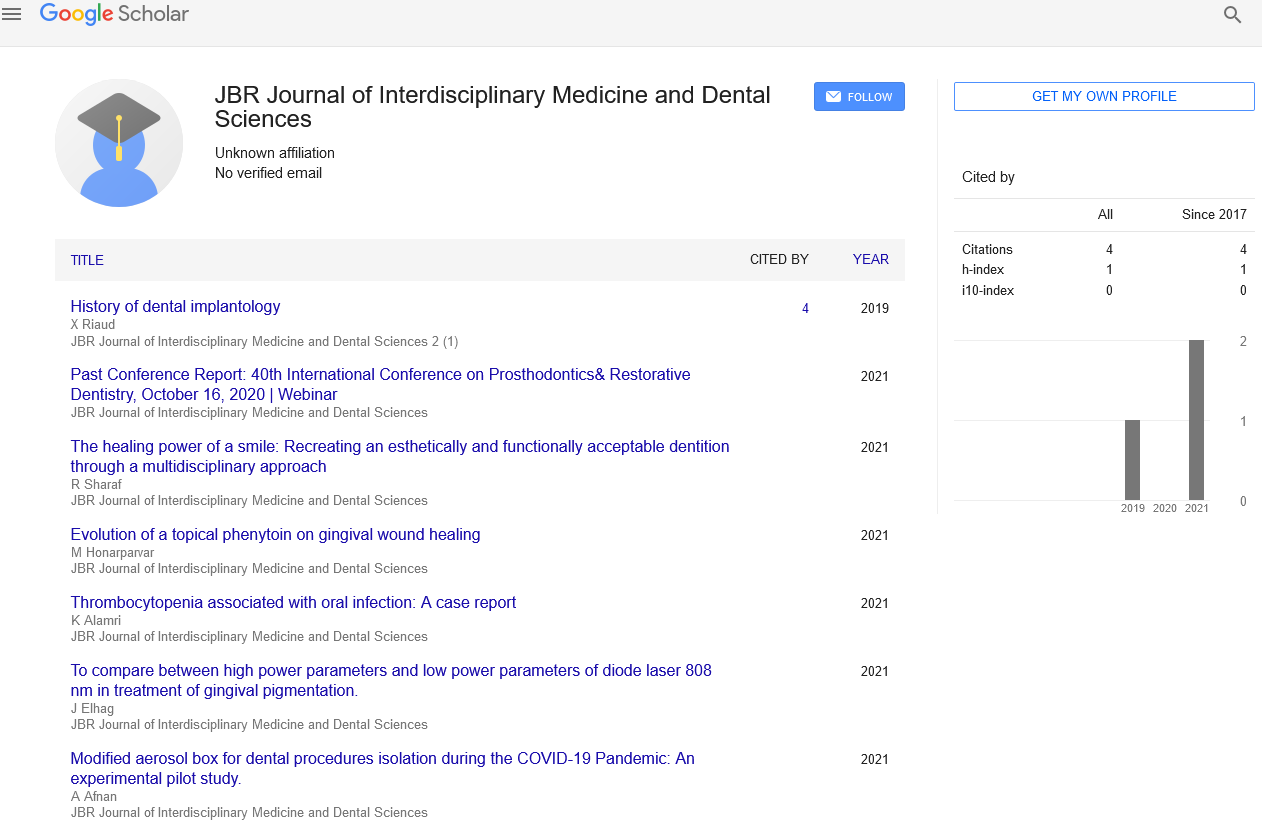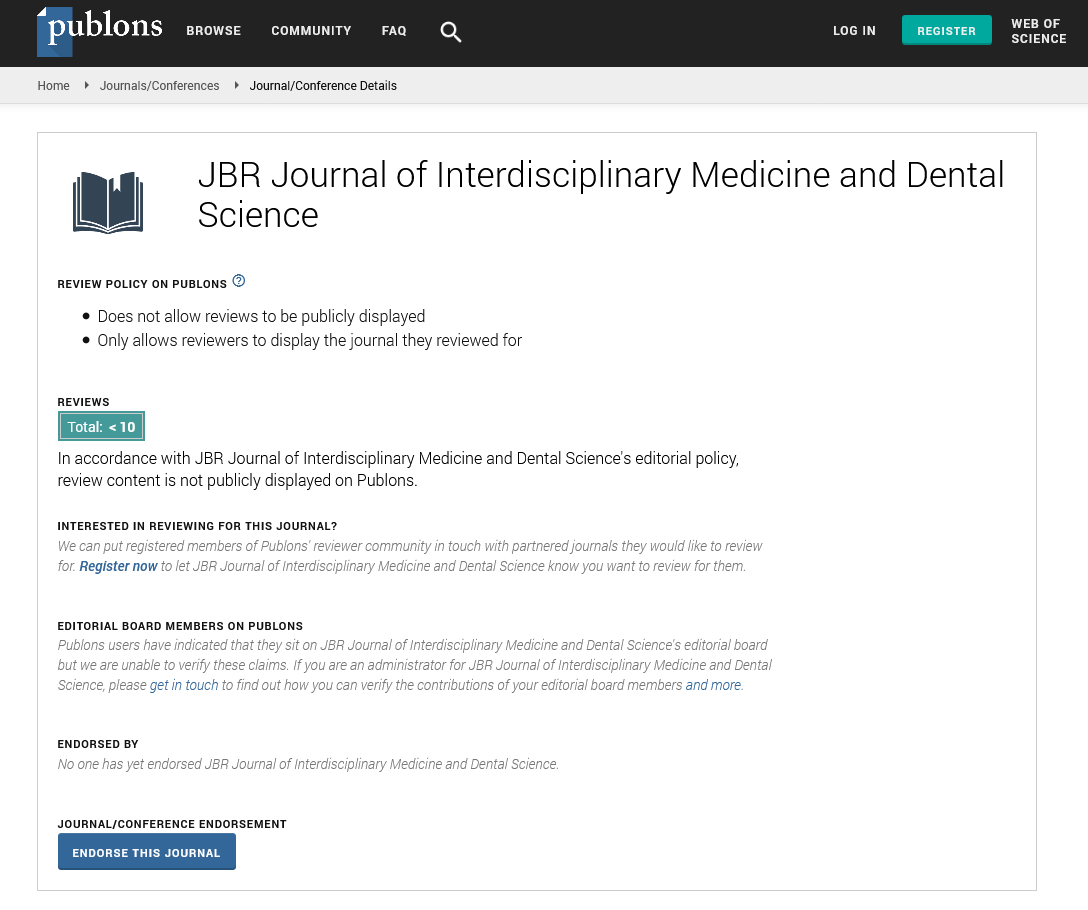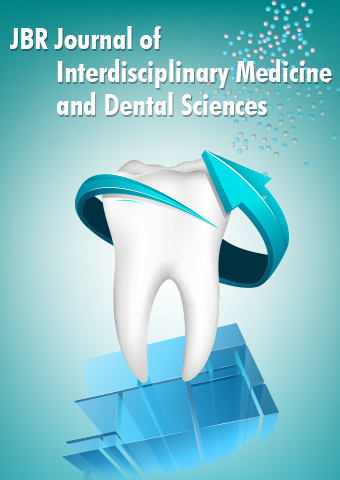Case Report - JBR Journal of Interdisciplinary Medicine and Dental Sciences (2023) Volume 6, Issue 4
Oral Pathology: Understanding Diseases of the Oral Cavity
Gabar Jain*
Department of Dental Pathology, Japan
Department of Dental Pathology, Japan
E-mail: jain_gabar@gmail.com
Received: 1-July-2023, Manuscript No. jimds-23-107845; Editor assigned: 4-July-2023, PreQC No. jimds-23-107845 (PQ); Reviewed: 19-July-2023, QC No. jimds-23-107845; Revised: 24-July-2023, Manuscript No. jimds-23-107845 (R); Published: 31-July-2023, DOI: 10.37532/2376- 032X.2023.6(4).68-71
Abstract
Oral pathology is a specialized branch of dentistry concerned with the study, diagnosis, and treatment of diseases affecting the oral cavity. This abstract provides an overview of the key aspects and importance of oral pathology in dental practice. The oral cavity serves as a gateway to the human body, and its health significantly impacts overall well-being. A wide range of diseases can manifest in the oral cavity, including infections, inflammatory conditions, neoplastic growths, and autoimmune disorders. Understanding the underlying causes and manifestations of these diseases is crucial for early detection, accurate diagnosis, and timely intervention. In this abstract, we explore the etiology and pathogenesis of common oral diseases, such as dental caries, periodontal diseases, oral mucosal lesions, and oral cancers. Emphasis is placed on the role of risk factors, such as poor oral hygiene, tobacco and alcohol consumption, genetic predisposition, and immunosuppression, in the development and progression of these conditions. Additionally, modern diagnostic techniques, including radiographic imaging, biopsy, and molecular testing, are discussed to highlight the importance of accurate diagnosis for effective treatment planning. Early detection of oral pathologies not only improves treatment outcomes but can also be lifesaving in cases of malignancies. Furthermore, the abstract delves into the various treatment modalities employed in managing oral diseases. Conservative measures, such as oral hygiene instructions, topical applications, and antimicrobial therapies, are essential for maintaining oral health. For more advanced cases, surgical interventions, chemotherapy, and radiotherapy may be required.
Keywords
Oral pathology • Diseases of the oral cavity • Dentistry • Oral health • Dental diseases
Introduction
The oral cavity, a crucial gateway to the human body, plays a fundamental role in various essential functions, such as communication, mastication, and digestion. However, this dynamic environment is also susceptible to a wide array of diseases that can significantly impact oral health and, in turn, the overall well-being of an individual [1]. Oral pathology, a specialized branch of dentistry, delves into the study, diagnosis, and treatment of these diseases, seeking to unravel their underlying causes, manifestations, and treatment modalities [2]. This introduction aims to shed light on the importance of understanding diseases of the oral cavity and the pivotal role oral pathology plays in modern dental practice. From dental caries to oral cancers, a diverse spectrum of oral diseases poses challenges to oral health professionals, necessitating a comprehensive approach to combat them effectively [3]. In this context, the etiology and pathogenesis of common oral diseases, including dental caries, periodontal diseases, oral mucosal lesions, and oral cancers, require thorough investigation. The multifactorial nature of these conditions demands a keen understanding of risk factors, such as poor oral hygiene, tobacco and alcohol consumption, genetic predisposition, and immunosuppression, to unravel their intricate mechanisms and devise appropriate treatment strategies [4]. Moreover, the development and refinement of modern diagnostic techniques have transformed oral pathology into a precise and nuanced science. Radiographic imaging, biopsy, and molecular testing have emerged as essential tools in accurate disease detection, enabling early intervention and improved treatment outcomes [5]. With the potential to diagnose malignancies at their nascent stages, these advancements emphasize the criticality of timely and precise diagnoses in enhancing patient prognosis. Considering the array of treatment modalities available for managing oral diseases, clinicians must navigate a vast landscape of options to devise personalized treatment plans [6]. While conservative measures, such as oral hygiene instructions, topical applications, and antimicrobial therapies, are the cornerstone of preventive dentistry, complex cases often require surgical interventions, chemotherapy, and radiotherapy [7]. An awareness of the indications and limitations of each treatment approach is indispensable for dental practitioners to optimize patient care and treatment success. Furthermore, this introduction emphasizes the significance of preventive dentistry and patient education in curbing the incidence and severity of oral pathologies [8]. Regular dental checkups, lifestyle modifications, and proactive patient involvement lay the groundwork for early detection and timely intervention, empowering individuals to actively safeguard their oral health. As oral pathology continues to evolve through research and technological advancements, the collective efforts of dental professionals aim to unravel the mysteries surrounding diseases of the oral cavity [9]. By cultivating a comprehensive understanding of the intricacies of oral diseases, dental practitioners can enhance their ability to identify, diagnose, and treat these conditions, ultimately contributing to the betterment of oral health and overall quality of life for patients [10].
Discussion
Oral pathology: unravelling the mysteries of diseases affecting the oral cavity
The oral cavity serves as a window into the overall health of an individual, with its condition significantly impacting various essential functions such as communication, mastication, and digestion. Unfortunately, this dynamic environment is susceptible to a diverse range of diseases that can profoundly affect oral health and overall well-being. The field of oral pathology, a specialized branch of dentistry, has emerged as a vital discipline dedicated to understanding, diagnosing, and treating diseases affecting the oral cavity. In this article, we delve into the fascinating world of oral pathology and its critical role in modern dental practice.
Understanding the spectrum of oral diseases
The oral cavity is not immune to diseases, and its health can be compromised by various factors, leading to conditions such as dental caries, periodontal diseases, oral mucosal lesions, and oral cancers. Dental caries, commonly known as tooth decay, results from the interaction between bacteria, carbohydrates, and tooth structure. Periodontal diseases, on the other hand, affect the supporting structures of the teeth and are primarily caused by plaque and tartar buildup. Oral mucosal lesions encompass a wide array of conditions, from benign growths to potentially malignant disorders, while oral cancers present a significant threat to oral and systemic health, necessitating early detection and intervention.
Unravelling the etiology and pathogenesis
The development of oral diseases is rarely straightforward, often arising from a combination of factors. For instance, dental caries may result from poor oral hygiene, frequent consumption of sugary foods, and the presence of certain bacterial strains. Similarly, periodontal diseases can be influenced by genetic predisposition, smoking, stress, and underlying systemic conditions like diabetes. Understanding these multifactorial etiologies is crucial for effective disease management and preventive strategies.
Diagnostic advancements in oral pathology
The advent of modern diagnostic techniques has transformed oral pathology into a more precise and sophisticated discipline. Radiographic imaging, including digital X-rays and conebeam computed tomography (CBCT), allows for detailed visualization of dental and bone structures, aiding in the detection of caries, bone loss, and tumors. Biopsy procedures provide valuable insights into the nature of oral lesions, helping differentiate benign conditions from potentially malignant ones. Moreover, molecular testing and genetic profiling have opened new avenues for early detection and personalized treatment approaches, especially in cases of oral cancers.
Treatment modalities and the importance of precision
Effective management of oral diseases necessitates tailored treatment plans that consider the patient’s unique needs and the nature of the condition. Conservative measures, such as professional cleanings, fluoride applications, and antimicrobial therapies, play a central role in preventing and managing dental caries and periodontal diseases. Surgical interventions, including root canal treatments and periodontal surgeries, are employed to address more advanced cases. In instances of oral cancers, a multidisciplinary approach combining surgery, radiation, and chemotherapy may be required. Precise understanding and application of these treatment modalities are crucial for achieving favourable outcomes and preserving oral function and aesthetics.
Preventive dentistry and patient empowerment: As the age-old adage goes, prevention is better than cure. Preventive dentistry is a cornerstone of oral health, aiming to minimize the occurrence of oral diseases through proactive measures. Regular dental check-ups allow for early detection and intervention, preventing minor issues from escalating into more significant problems. Emphasizing oral hygiene practices, proper nutrition, and lifestyle modifications empower individuals to take charge of their oral health, reducing the risk of oral diseases and fostering a lifetime of well-being.
Advancing oral pathology for better health
The pursuit of knowledge in oral pathology is an ongoing journey, driven by continuous research and collaboration among dental professionals. With each new discovery and technological advancement, the scope of oral pathology widens, equipping dental practitioners with enhanced diagnostic capabilities and treatment options. By embracing this ever-evolving field, oral health professionals can better serve their patients, providing them with the best possible care and improving the quality of life for individuals and communities alike.
Conclusion
In conclusion, oral pathology stands as a pivotal discipline within dentistry, dedicated to unraveling the complexities of diseases affecting the oral cavity. The significance of this field lies in its capacity to foster a deeper understanding of the etiology, pathogenesis, and treatment modalities of various oral conditions, ensuring optimal care for patients and improving overall oral health. Through comprehensive research and advancements in diagnostic techniques, dental professionals can now identify oral pathologies with greater precision and at earlier stages, enabling timely intervention and potentially lifesaving treatments, especially in cases of oral cancers. The utilization of radiographic imaging, biopsies, and molecular testing has revolutionized the diagnostic landscape, empowering dental practitioners to provide accurate and tailored treatment plans, thereby enhancing patient outcomes. Moreover, recognizing the multifactorial nature of oral diseases emphasizes the importance of addressing risk factors through preventive dentistry and patient education. By promoting regular dental check-ups, emphasizing oral hygiene practices, and encouraging lifestyle modifications, oral health professionals can play an active role in minimizing the incidence and severity of oral pathologies. Furthermore, the diverse range of treatment modalities available underscores the need for a personalized approach to patient care. By understanding the indications and limitations of various interventions, dental practitioners can optimize treatment success and improve patient well-being. As oral pathology continues to evolve, ongoing research and collaboration within the dental community will further enrich our comprehension of diseases of the oral cavity. By continually refining diagnostic and treatment approaches, oral health professionals can better serve their patients and contribute to advancements in oral healthcare. In the face of emerging challenges and new discoveries, the pursuit of knowledge within oral pathology remains integral to the dental profession. By embracing the insights gleaned from this field, dental practitioners can play an active role in preventing, diagnosing, and treating diseases of the oral cavity, ensuring a brighter and healthier future for their patients. As we continue to deepen our understanding of oral pathologies, the ultimate goal remains unchanged - to enhance the well-being and oral health of individuals and communities worldwide.
References
- Cambon-Thomsen A, Rial-Sebbag E, Knoppers BM et al. Trends in ethical and legal frameworks for the use of human biobanks. J EUR R. 30, 373-382 (2007).
- Dietrich E, Powell J, Taylor JR et al. Canagliflozin: a novel treatment option for type 2 diabetes. Drug Des Devel Ther. 7, 1399-1408 (2013).
- Pratley RE, McCall T, Fleck PR et al. Alogliptin use in elderly people: a pooled analysis from phase 2 and 3 studies. Am Geriatr Soc. 57, 2011-2019 (2009)?
- Pratley RE, Rosenstock J, Pi-Sunyer FX et al. Management of type 2 diabetes in treatment-naive elderly patients: benefits and risks of vildagliptin monotherapy. Diabetes Care. 30, 3017-3022 (2007).
- Doucet J, Chacra A, Maheux Pet et al. Efficacy and safety of saxagliptin in older patients with type 2 diabetes mellitus. Curr Med Res Opin. 27, 863-869 (2011).
- Amori RE, Lau J, Pittas AG et al. Efficacy and safety of incretin therapy in type 2 diabetes: systematic review and meta-analysis. JAMA. 298, 194-206 (2007).
- Cvetković RS, Plosker GL. Exenatide: a review of its use in patients with type 2 diabetes mellitus (as an adjunct to metformin and/or a sulfonylurea). Drugs. 67, 935-954 (2007).
- Gallwitz B. Exenatide in type 2 diabetes: treatment effects in clinical studies and animal study data. Int J Clin Pract. 60, 1654-1661 (2006).
- Briones M, Bajaj M. Exenatide: a GLP-1 receptor agonist as novel therapy for Type 2 diabetes mellitus. Expert Opin Pharmacother. 7, 1055-1064 (2006).
- Verdonck LF, Sangster B, van Heijst AN et al. Buformin concentrations in a case of fatal lactic acidosis. Diabetologia. 20, 45-46 (1981).
Indexed at, Google Scholar, Crossref
Indexed at, Google Scholar, Crossref
Indexed at, Google Scholar, Crossref
Indexed at, Google Scholar, Crossref
Indexed at, Google Scholar, Crossref
Indexed at, Google Scholar, Crossref
Indexed at, Google Scholar, Crossref
Indexed at, Google Scholar, Crossref
Indexed at, Google Scholar, Crossref


